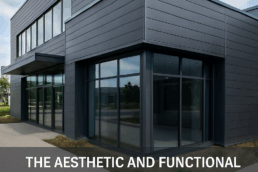Metal fabrication and welding are two critical processes in the manufacturing industry. While they often go hand-in-hand, they serve distinct functions and are applied differently depending on the project’s requirements. Metal fabrication is a broad term that encompasses a variety of processes to create metal structures and components from raw materials.
On the other hand, welding is a specific technique within the realm of metal fabrication that focuses on joining metal pieces together. Understanding the differences between these two processes is important for selecting the right methods for your manufacturing or construction project. This blog highlights the key differences between metal fabrication and welding to help you understand their distinct roles and applications.
What is Metal Fabrication?
Metal fabrication involves creating metal structures and components through processes like cutting, bending, and assembling. It covers a wide range of techniques to produce final products from raw metal materials. The goal of metal fabrication is to transform raw metal sheets or bars into usable products, whether they are large structural components or intricate parts for machinery. This process is fundamental to various industries such as construction, automotive, aerospace, and consumer goods. It has become an essential part of modern manufacturing.
Techniques in Metal Fabrication
- Cutting: This is the initial stage where raw metal is cut into the required shapes and sizes. Methods include shearing, laser cutting, plasma cutting, and waterjet cutting.
- Bending: After cutting, the metal pieces are bent into specific angles and shapes using machines like press brakes.
- Assembling: The final stage where different metal parts are joined together. This can involve various methods, including welding, riveting, and bolting.
Applications of Metal Fabrication
Metal fabrication is used in a myriad of industries. This includes construction, automotive, aerospace, and electronics. It is vital for creating structural components, vehicle bodies, aircraft parts, and electronic enclosures, among others. The versatility of metal fabrication allows for the creation of large-scale structures like buildings and bridges. It also enables the formation of small, precise components used in various devices.
What is Welding?
Welding is a specific process within metal fabrication that focuses on joining two or more metal pieces together using heat and pressure. It is a critical technique in the assembly phase of metal fabrication, ensuring that metal parts are securely fused to create a single, solid piece.
Welding involves melting the base materials and often adding a filler material to form a strong joint upon cooling. The quality of the weld is crucial as it affects the strength and durability of the final product.
Techniques in Welding
Welding covers various methods, each suitable for different materials and applications:
- MIG Welding (Metal Inert Gas): Uses a continuous wire feed as an electrode and an inert gas to shield the weld from contamination. MIG welding is known for its speed and ease of use. It is ideal for both thick and thin materials.
- TIG Welding (Tungsten Inert Gas): Utilizes a tungsten electrode to produce the weld and an inert gas for shielding. TIG welding offers high precision and control, making it suitable for delicate and high-quality welds. It is commonly used for welding thin sections of stainless steel and non-ferrous metals such as aluminum, magnesium, and copper alloys.
- Stick Welding: Employs a consumable electrode coated in flux. It is versatile and can be used in various environments, including outdoor and underwater applications. Stick welding is highly effective for welding thicker materials and is often used in construction and heavy-duty manufacturing.
- Spot Welding: Used for joining overlapping metal sheets and involves pressing the sheets between electrodes and applying a high current. Spot welding is commonly used in the automotive industry for assembling car bodies and in other applications where metal sheets need to be joined quickly and efficiently.
Applications of Welding
Welding is essential in the manufacturing and repair of metal structures and machinery. It is used extensively in the construction of buildings, ships, and automobiles, as well as in the fabrication of pressure vessels, pipelines, and heavy equipment. Welding ensures the integrity and strength of joints, which is vital for the safety and performance of the final products. In addition to traditional industries, welding plays a vital role in emerging fields such as renewable energy. In this field, it is used in the assembly of wind turbines, solar panels, and other energy systems.
Key Differences Between Metal Fabrication and Welding
Scope
- Metal Fabrication: Covers a broader range of processes, including cutting, bending, assembling, and more. It is the entire process of creating metal structures from start to finish.
- Welding: This is a specialized joining technique that is part of the metal fabrication process. It specifically focuses on fusing metal pieces together.
Techniques
- Metal Fabrication: Includes a variety of methods such as cutting, bending, forming, and welding. Each technique is chosen based on the requirements of the final product.
- Welding: Specifically involves melting and fusing metals using heat and sometimes pressure. It can be one of the techniques used during the assembly phase of metal fabrication.
Applications
- Metal Fabrication: Used to create complete structures or products from raw metal materials. This can include everything from architectural frameworks to intricate machinery parts.
- Welding: Often used as part of the metal fabrication process to assemble components. While it is critical for creating strong joints, it is not used in isolation but rather as a part of the broader fabrication workflow.
Understanding the differences between metal fabrication and welding is essential for selecting the right process for your project. While metal fabrication encompasses various techniques for transforming raw metal into finished products, welding is a specialized method focused on joining metal parts. Recognizing the distinct roles and applications of each can help you make informed decisions in manufacturing and construction.
At C&J Metal Products, we specialize in both metal fabrication and welding services, ensuring high-quality, precise, and durable results for your projects. Contact us today to learn how our expertise can support your manufacturing needs and bring your designs to life.



